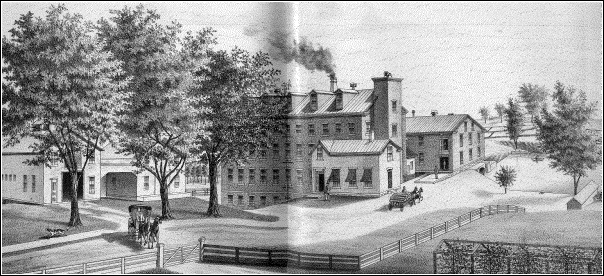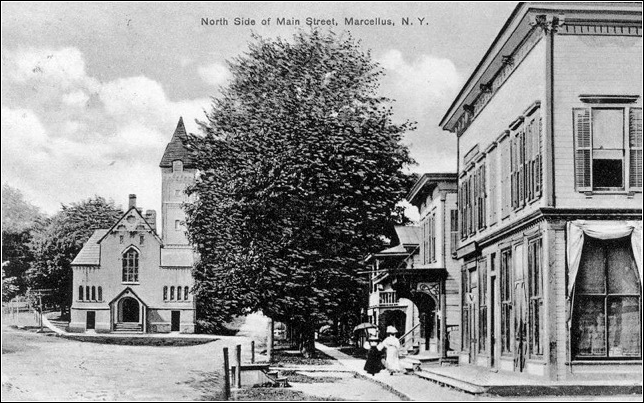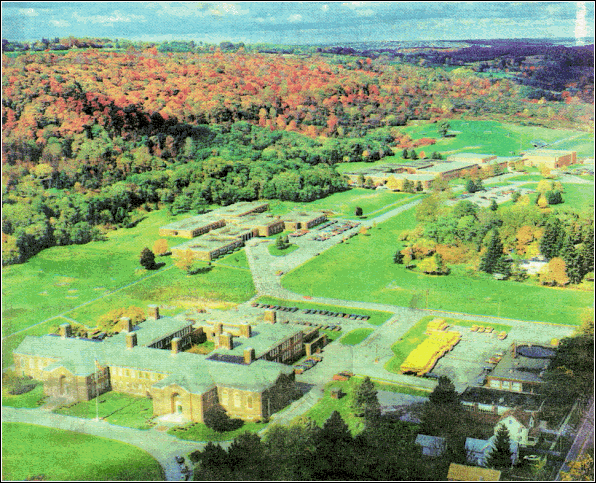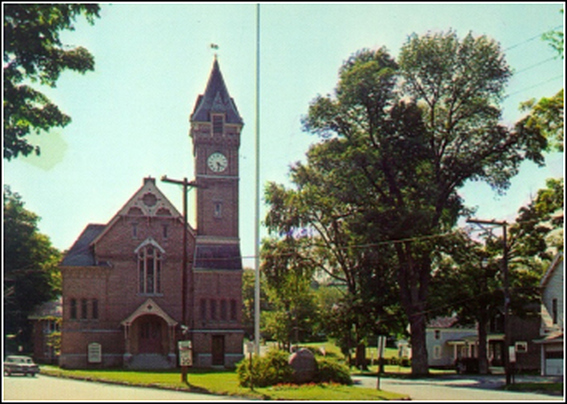A Brief History
The history of Marcellus dates back to the period after the American Revolutionary War, when land was set aside for veterans of that war, in recognition of their service in the war. Marcellus, like much of Onondaga County, was part of the Military Tract, called Township Nine. Later, proper names were desired and the Towns in the Military Tract were named after famous people, many of them ancient Greeks and Romans. Marcellus was a Roman general (noted for having conquered the fortified city of Syracuse), as was Pompey, Camillus was a Roman statesman
as was Manlius. Many of the Revolutionary War soldiers sold their land to others, and it was these others who became the early settlers of Marcellus in the 1790s and early 1800s. These early settlers were mostly families from New England who were attracted to the area by two things - its abundant water and its good soil.
Many settled on the eastern and western hills around the valley of Nine Mile Creek, while others settled in the valley. It was here that the Village developed - at the crossroads of two major transportation routes -Nine Mile Creek and Seneca Turnpike.
as was Manlius. Many of the Revolutionary War soldiers sold their land to others, and it was these others who became the early settlers of Marcellus in the 1790s and early 1800s. These early settlers were mostly families from New England who were attracted to the area by two things - its abundant water and its good soil.
Many settled on the eastern and western hills around the valley of Nine Mile Creek, while others settled in the valley. It was here that the Village developed - at the crossroads of two major transportation routes -Nine Mile Creek and Seneca Turnpike.
Seneca Turnpike, an outgrowth of the Great Native American Trail that stretched across the State of New York, was a major highway for people and products moving from New England and the settled east to what was then the western frontier. The original trail was practically a straight line through what became Marcellus Village, but when the State of New York laid out the Turnpike for improvement in 1802, the road-bed was changed to its present location on its way west out of the Village in order to avoid the steep climb. Stagecoach lines operating on the turnpike helped the area, particularly the valley of the Nine Mile, to develop and expand as a trading and
manufacturing center. There were a number of business establishments on the Turnpike, including the famous Alvord house, built in 1815 and located strategically in the valley for servicing those who traveled the highway.
These early settlers brought their families and built their homes. They also brought their faith and belief in education, as evidenced by the building of the first church structure in Onondaga County in 1803 and the erecting of schoolhouses, some made of logs, throughout the area. The first burying ground in Marcellus was a plot located on South Street. After the building of the first meetinghouse on the corner of North Street, a site adjacent to the church seemed more desirable. In 1804, the village cemetery on North Street was opened and bodies from the original plot were transferred to the new burial ground. During the War of 1812, although Marcellus was largely unaffected by that conflict, veterans of that war would also be buried here.
It was not only the soil that attracted the New Englanders. The power of Nine Mile Creek attracted a great many people interested in milling operations and the first was a sawmill built in 1796, in back of what is now the McClurg Building on East Main Street.
As the roads improved, more people made their way west by stagecoach, and more businesses began to operate on the creek, whose waterpower (a 200-foot drop from the Village to Marcellus Falls) caused the building of more sawmills, paper mills, woolen factories, a gristmill, a furniture factory, a barley mill, a plaster mill and a flax mill. There were also dry goods stores, grocery stores, drugstores, a hat store and two taverns, including one operated by Deacon Rice (today the site of SFX Catholic Church), as well as the Alvord House, which opened in 1815, and is still in operation today. In addition, more business and professional men and their families began to erect large
mansions in the Village, and by 1840, a growing community had been firmly planted.
With more people moving into the community, more churches were built, including St. John's Episcopal Church, now on Orange Street and the Methodist Church on West Main Street. Soon, as a great many immigrant families arrived from Ireland, many to work in the mills, St. Francis Xavier Catholic Church was also constructed. Marcellus was, at one time, known as a Village of Churches, with one on each corner.
manufacturing center. There were a number of business establishments on the Turnpike, including the famous Alvord house, built in 1815 and located strategically in the valley for servicing those who traveled the highway.
These early settlers brought their families and built their homes. They also brought their faith and belief in education, as evidenced by the building of the first church structure in Onondaga County in 1803 and the erecting of schoolhouses, some made of logs, throughout the area. The first burying ground in Marcellus was a plot located on South Street. After the building of the first meetinghouse on the corner of North Street, a site adjacent to the church seemed more desirable. In 1804, the village cemetery on North Street was opened and bodies from the original plot were transferred to the new burial ground. During the War of 1812, although Marcellus was largely unaffected by that conflict, veterans of that war would also be buried here.
It was not only the soil that attracted the New Englanders. The power of Nine Mile Creek attracted a great many people interested in milling operations and the first was a sawmill built in 1796, in back of what is now the McClurg Building on East Main Street.
As the roads improved, more people made their way west by stagecoach, and more businesses began to operate on the creek, whose waterpower (a 200-foot drop from the Village to Marcellus Falls) caused the building of more sawmills, paper mills, woolen factories, a gristmill, a furniture factory, a barley mill, a plaster mill and a flax mill. There were also dry goods stores, grocery stores, drugstores, a hat store and two taverns, including one operated by Deacon Rice (today the site of SFX Catholic Church), as well as the Alvord House, which opened in 1815, and is still in operation today. In addition, more business and professional men and their families began to erect large
mansions in the Village, and by 1840, a growing community had been firmly planted.
With more people moving into the community, more churches were built, including St. John's Episcopal Church, now on Orange Street and the Methodist Church on West Main Street. Soon, as a great many immigrant families arrived from Ireland, many to work in the mills, St. Francis Xavier Catholic Church was also constructed. Marcellus was, at one time, known as a Village of Churches, with one on each corner.
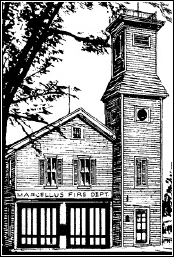
In 1861, the American Civil War began, with many Marcellians (over 200) enlisting in the 122nd, 149th and 185th regiments, among others. A number of casualties of that war were interred in the Village Cemetery on North Street as well as the new Catholic Cemetery on West Hill, which opened in 1862. The woolen mills of Marcellus became a major supplier of (woolen) uniforms to the Union Army while other mills continued to provide employment as well as products for the surrounding community.
In the 1870s, the Lawless family set up a paper mill in Marcellus Falls that employed a great many Irish
immigrants, and in the 1880s, Edward Moir came to Marcellus, took over the lower woolen mill and recruited many skilled workers from Scotland and Canada. In the Village, William Gallup built a post office building on the corner of North and Main Streets and in the middle of Main Street a village pump was readily available for residents.
After a series of disastrous fires, including one that destroyed St. John's Church on West Main Street and the old Stone Mill on East Main Street, Village residents supported the establishment of a volunteer fire department and the construction of a firehouse in the 1880s.
By the 1890s, Marcellus was still a horse and buggy community, a small village in the valley where most people were either employed in the local mills, or served the surrounding farming community. The people educated their children in the Village school and after the Union Free School District was formed in 1891, a new school was built in 1892 on West Main Street. This structure would serve all grades through high school until 1936, when a new, centralized school was built on Reed Parkway.
By 1900, the Marcellus and Otisco Lake Railroad was created - one of the shortest carriers in the U.S., crossing Nine Mile Creek on its way to Otisco Lake and in 1903, the Auburn and Syracuse Electric Trolley began operation.
The Marcellus Telephone Company started at the turn of the century and the first electric power from Baker's Dam on Nine Mile Creek was used to light several homes and businesses in the Village.
The Village added public water for its residents in 1908 and while the Marcellus Volunteers continued to serve the public out of its Engine House on Slocombe Ave, the Trolley brought people from Auburn to Syracuse on a regular basis. Businesses continued to expand, particularly the mills on the creek, while in the Village Center, the Marcellus Bank, Woodbridge's Dry Goods, Wybron's Store, Marble's Drug Store, and a new library served the public. In 1914, a great celebration, "Olde Home Week" was held,
In the 1870s, the Lawless family set up a paper mill in Marcellus Falls that employed a great many Irish
immigrants, and in the 1880s, Edward Moir came to Marcellus, took over the lower woolen mill and recruited many skilled workers from Scotland and Canada. In the Village, William Gallup built a post office building on the corner of North and Main Streets and in the middle of Main Street a village pump was readily available for residents.
After a series of disastrous fires, including one that destroyed St. John's Church on West Main Street and the old Stone Mill on East Main Street, Village residents supported the establishment of a volunteer fire department and the construction of a firehouse in the 1880s.
By the 1890s, Marcellus was still a horse and buggy community, a small village in the valley where most people were either employed in the local mills, or served the surrounding farming community. The people educated their children in the Village school and after the Union Free School District was formed in 1891, a new school was built in 1892 on West Main Street. This structure would serve all grades through high school until 1936, when a new, centralized school was built on Reed Parkway.
By 1900, the Marcellus and Otisco Lake Railroad was created - one of the shortest carriers in the U.S., crossing Nine Mile Creek on its way to Otisco Lake and in 1903, the Auburn and Syracuse Electric Trolley began operation.
The Marcellus Telephone Company started at the turn of the century and the first electric power from Baker's Dam on Nine Mile Creek was used to light several homes and businesses in the Village.
The Village added public water for its residents in 1908 and while the Marcellus Volunteers continued to serve the public out of its Engine House on Slocombe Ave, the Trolley brought people from Auburn to Syracuse on a regular basis. Businesses continued to expand, particularly the mills on the creek, while in the Village Center, the Marcellus Bank, Woodbridge's Dry Goods, Wybron's Store, Marble's Drug Store, and a new library served the public. In 1914, a great celebration, "Olde Home Week" was held,
enjoyed by thousands, and it still ranks as one of the greatest events in the history of Marcellus. Although more and more houses were built in the Village before the war, the streets in the Village remained unpaved before the war and sidewalks were a luxury for pedestrian traffic.
A number of young men from Marcellus marched off to the Great War in 1917, while others, including many women, continued to serve as volunteers at home. When the war ended, many Americans wanted to retreat to the small towns that had once been their splendid isolation, but the years ahead were somewhat anxious ones.
The 1920s witnessed some business expansion, including Cummings Candy and Whitfield's hotdog stand, increased involvement in the Fire Department, a growth in church services, and in 1927, a new Veterans' Monument was placed in the center of the Village, at the "Point," where it remains a center of community life. This was also the age of sports heroes and an interest in both athletics and music found its way into the school curriculum. Education continued to expand in Marcellus, and by 1936 the old school on the hill was replaced with a new centralized school at the end of First Street, just outside the Village. The 20s also witnessed the age of the automobile, as evidenced
by the extension of Seneca Turnpike from Marcellus to Onondaga Hill, and an increasing number of cars on Main Street. The 1930s saw the opening of The Strand, Marcellus' first movie theater - this was the age of movies, even talkies and movie stars. Despite the Depression of the '30s, many Marcellians still found employment in the local mills.
In 1940, several improvements were being made to Marcellus Park, but many young Marcellus men and women, would have to wait to enjoy it, since they were again marching off to war. Back home, Marcellians lived with ration coupons, planted Victory Gardens, and the Strand Theater showed newsreels of combat in Europe and the Pacific. When the soldiers came home from the war in 1945, the American Legion had purchased the Coyne building to help returning veterans after the war. The Legion remains an important part of the Marcellus community today.
During the 1950s, there was continued employment in the local mills, but the future did not look good for the business. The Village celebrated its 100th anniversary in 1953, and as the baby boomers began to grow older in the 1950s, there was an increasing need for more school classrooms. KCH Elementary and Kasson Road Elementary schools were built, and in a few years a new high school would also be built.
A number of young men from Marcellus marched off to the Great War in 1917, while others, including many women, continued to serve as volunteers at home. When the war ended, many Americans wanted to retreat to the small towns that had once been their splendid isolation, but the years ahead were somewhat anxious ones.
The 1920s witnessed some business expansion, including Cummings Candy and Whitfield's hotdog stand, increased involvement in the Fire Department, a growth in church services, and in 1927, a new Veterans' Monument was placed in the center of the Village, at the "Point," where it remains a center of community life. This was also the age of sports heroes and an interest in both athletics and music found its way into the school curriculum. Education continued to expand in Marcellus, and by 1936 the old school on the hill was replaced with a new centralized school at the end of First Street, just outside the Village. The 20s also witnessed the age of the automobile, as evidenced
by the extension of Seneca Turnpike from Marcellus to Onondaga Hill, and an increasing number of cars on Main Street. The 1930s saw the opening of The Strand, Marcellus' first movie theater - this was the age of movies, even talkies and movie stars. Despite the Depression of the '30s, many Marcellians still found employment in the local mills.
In 1940, several improvements were being made to Marcellus Park, but many young Marcellus men and women, would have to wait to enjoy it, since they were again marching off to war. Back home, Marcellians lived with ration coupons, planted Victory Gardens, and the Strand Theater showed newsreels of combat in Europe and the Pacific. When the soldiers came home from the war in 1945, the American Legion had purchased the Coyne building to help returning veterans after the war. The Legion remains an important part of the Marcellus community today.
During the 1950s, there was continued employment in the local mills, but the future did not look good for the business. The Village celebrated its 100th anniversary in 1953, and as the baby boomers began to grow older in the 1950s, there was an increasing need for more school classrooms. KCH Elementary and Kasson Road Elementary schools were built, and in a few years a new high school would also be built.
During the 1960s, many of the mills, which had once employed so many people, were closing down because of foreign
competition and Marcellus was becoming more like a bedroom community, the interest of many residents revolving around
the largest employer in the area - the school. In the 1970s and 1980s, there was little change in the population of
Marcellus, and it also appeared that the Village needed an urban renewal of sorts.
As the 1990s merged into the new millennium, some significant facelifts in the community began with major street
and drainage improvements, along with new banners, signs, benches, planters and historic lighting, which helped to
beautify the Village. Improvements to Marcellus Park, Marcellus School, and new businesses helped provide a refreshed
identity for the community. The Olde Home Days, revived in 1995, continues to attract more and more interest each year,
uniting the community in a family oriented happening, where old friends are found and new friends are made.
Today, the churches continue to play an important role in the life of the Marcellus community, as they have throughout
its history. Community landmarks such as the Village Cemetery and the Steadman House, home of the Marcellus Historical
Society, remind residents of their past - a precious look back. The new Marcellus Free Library promotes a continued
interest in learning, and Marcellians are always excited to hear about the academic, scholastic and athletic
accomplishments of Marcellus Central School students.
Marcellus began over 200 years ago, settled at a crossroads, by people who were attracted by the abundant resources that
Nine Mile offered. Today, the creek still flows north, and attracts many fishermen and lovers of nature, but the mills
are gone, and fewer people are engaged in farming. So what makes Marcellus attractive today? Why do people settle in
Marcellus today? There are a great many reasons, but the one that stands out is the schools, and those students who
help to maintain a great reputation for academic and scholastic as well as athletic success.
competition and Marcellus was becoming more like a bedroom community, the interest of many residents revolving around
the largest employer in the area - the school. In the 1970s and 1980s, there was little change in the population of
Marcellus, and it also appeared that the Village needed an urban renewal of sorts.
As the 1990s merged into the new millennium, some significant facelifts in the community began with major street
and drainage improvements, along with new banners, signs, benches, planters and historic lighting, which helped to
beautify the Village. Improvements to Marcellus Park, Marcellus School, and new businesses helped provide a refreshed
identity for the community. The Olde Home Days, revived in 1995, continues to attract more and more interest each year,
uniting the community in a family oriented happening, where old friends are found and new friends are made.
Today, the churches continue to play an important role in the life of the Marcellus community, as they have throughout
its history. Community landmarks such as the Village Cemetery and the Steadman House, home of the Marcellus Historical
Society, remind residents of their past - a precious look back. The new Marcellus Free Library promotes a continued
interest in learning, and Marcellians are always excited to hear about the academic, scholastic and athletic
accomplishments of Marcellus Central School students.
Marcellus began over 200 years ago, settled at a crossroads, by people who were attracted by the abundant resources that
Nine Mile offered. Today, the creek still flows north, and attracts many fishermen and lovers of nature, but the mills
are gone, and fewer people are engaged in farming. So what makes Marcellus attractive today? Why do people settle in
Marcellus today? There are a great many reasons, but the one that stands out is the schools, and those students who
help to maintain a great reputation for academic and scholastic as well as athletic success.
The original corporation of the Village consisted of a little over 282 acres of land - about 2/3's the present size of the Village. The eastern and western boundaries of the Village have changed little since 1853. Nine Mile Creek is basically the eastern boundary of the village, and the hills called the Lime Ledge mark off the western edge.
On the north, the village line originally ended where, Driver Middle School now begins. A 1906 annexation would add about 70 acres to the
northern boundary of the Village including what is commonly referred to today as Scotch Hill. On the south, an annexation in 1978 added about 6 acres of land to that boundary. In front of the Methodist Church, across from the Village Office, a space of green and a Memorial Boulder mark the Village commons, and its history. It was a gathering place for pioneers, many moving west on this very road. Even today, it remains the heart of the Village and the community.
John P. Curtin, Mayor
Village of Marcellus
On the north, the village line originally ended where, Driver Middle School now begins. A 1906 annexation would add about 70 acres to the
northern boundary of the Village including what is commonly referred to today as Scotch Hill. On the south, an annexation in 1978 added about 6 acres of land to that boundary. In front of the Methodist Church, across from the Village Office, a space of green and a Memorial Boulder mark the Village commons, and its history. It was a gathering place for pioneers, many moving west on this very road. Even today, it remains the heart of the Village and the community.
John P. Curtin, Mayor
Village of Marcellus

